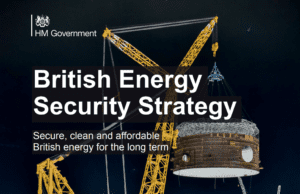
An Assessment of Current Environmental Policy in British Party Politics
With the 2022 local elections signifying the halfway point of the current Parliamentary session, and the 2024 General Election growing ever closer, it is important to assess the climate policies of both the Conservatives and Labour to ascertain how future legislation will seek to meet Net Zero commitments.
In the past few months, both parties have unveiled energy strategies establishing respective priorities for reaching carbon neutrality. First, in April the Conservative Government published the British Energy Security Strategy (ESS), with proposals including:[1]
- A commitment to deliver 50GW of offshore wind by 2030 aided by a 25 percent increase in the pace of deployment and regulatory reforms, such as the creation of a fast-track route for priority developments.
- A pledge to increase solar power five-fold by 2035 to 70GW annually, with a consultation on changing planning rules for ground-mounted solar in favour of development on non-protected land, and mitigations for any development on greenfield sites.
- Support for nuclear energy as the foundation of British energy security, with an aspiration for nuclear to provide a baseload of 25 percent of energy needs, or 24GW, for British consumers by 2050. This includes a commitment to building eight new nuclear reactors by the end of the decade, with assistance from a new body, the Great British Nuclear Vehicle.
- Investment in low carbon hydrogen to ensure production of at least 10GW by 2030, achieved through annual allocation rounds for electrolytic hydrogen so that 1GW is in construction or operational by 2025, and the establishment of a hydrogen certification scheme for export and import services.
- An overhaul of network infrastructure to anticipate need and to plan accordingly, with an ambition to halve the time taken to build green technology. The Future Systems Operator will be established to drive the overall energy transition, and a strategic framework published with Ofgem to set out how networks will deliver net zero.
Pre-empting the Government’s energy strategy, Labour unveiled it’s Five Point Plan for Energy Security in March 2022. In a visit to the University of Salford, Ed Miliband, Shadow Climate Change and Net Zero Secretary, announced five broad-based policies to ensure the transition to Net Zero:[2]
- An energy efficiency revolution to insulate 19 million homes in a decade, cut gas imports by 15% and cut bills by up to £400.
- Double onshore wind capacity to 30GW by 2030, to power an extra 10 million homes
- Increase offshore wind capacity to at least 75GW by 2035.
- Triple solar power by 2030, back tidal power and further investment in hydrogen.
- End the delay on nuclear power, confirming Sizewell C and backing SMRs.
Comparing Party Policy
Overall, there is much consensus between both parties. On offshore wind power, the Conservatives commit to achieving 50GW by 2030, whilst Labour has set a target of 75GW by 2035. For solar power, with present capacity at 14GW, the Government commits to reach 70GW by 2035, whilst Labour aspires to construct 42GW by 2030.[3] Both parties likewise agree to further investment in new technologies, such as hydrogen and tidal power. Finally, in a reversal from previous policy, Labour aligns with the Conservatives and has committed to investing in nuclear power, including SMRs – small modular reactors – which are enthusiastically embraced by the Government.
There does, however, exist differences between each party’s position. The Conservatives’ ESS is silent on home insulation, whilst Labour has placed it at the heart of its climate agenda, seeking to build political capital by associating green policies with money saving. Conversely, the Conservatives associate consumer savings with community connectivity to local network infrastructure.
Similarly, on onshore wind, the Government is once again limited in its ambition, with policies limited to consultation on the development of local partnerships designed to support communities wishing to host new onshore wind infrastructure with lower energy bills, and a commitment to servicing existing sites. Labour, alternatively, has pledged to double current capacity to reach 30GW by 2030. Finally, on nuclear, Labour is silent on its stance toward the construction of eight new power plants, likely owing to the contentious nature of nuclear power within the party.
Fundamentally, the Conservatives and Labour are united in their support for the green industrial revolution – the next two years, then, will decide how quickly, and in what form, such a project will be achieved.
[1] Department for Business, Energy, and Industrial Strategy, British Energy Security Strategy, https://www.gov.uk/government/publications/british-energy-security-strategy/british-energy-security-strategy
[2] Shadow Secretary of State Ed Miliband visits Salford’s Net Zero Research Facility, https://www.salford.ac.uk/news/shadow-secretary-state-ed-miliband-visits-salfords-net-zero-research-facility
[3] The Energyst, Labour commits to 40 GW of solar by 2 030, plus Sizewell C & mini nukes, https://theenergyst.com/labour-commits-to-40-gw-of-solar-by-2030-plus-sizewell-c-mini-nukes/